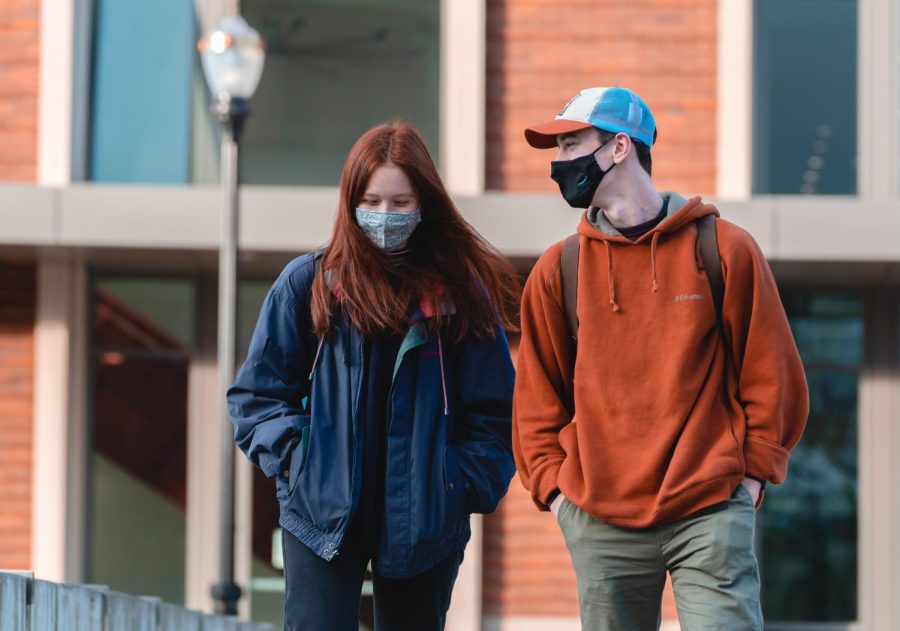COVID-19 cases on rise at OSU, up 8% from beginning of January
Oregon State University students Makena Apau, left, and Ethan Thompson are wearing masks as they walk out of the Learning Innovation Center on the Corvallis, Ore. campus on Jan. 31. COVID-19 cases are still high due to the omicron variant and many students at OSU have tested positive for COVID-19 since the beginning of the winter term.
February 7, 2022
About 11% of COVID-19 tests administered at Oregon State University came back positive between Jan. 24 to 30, climbing from a positive testing rate of 3% from Dec. 27 to Jan. 2.
This reflects a trend throughout Oregon as 13,443 new cases of COVID-19 emerged statewide over the weekend of Jan. 28 to 30—almost eight times that of the 1,761 positive cases recorded on Jan. 1, according to Oregon Health Authority’s Oregon COVID-19 Update on Feb. 1.
The record increase in case numbers can be attributed to the surge of omicron, a COVID-19 variant 70 times more contagious than the previously dominant delta variant, said Dr. Chunhuei Chi, director of the Center for Global Health at OSU.
“Quite a few counties, if not the majority of the counties, [throughout Oregon] have simply given up contact tracing,” Chi said. “The reason is the nature of omicron. It spread so fast and started to be contagious before any symptoms… That’s making it even harder to do contact tracing.”
According to Chi, 40% of people infected with omicron are asymptomatic, but are still able to spread the virus. These stealth infections can be missed if people don’t get tested when they’ve been exposed to someone with COVID-19.
On-campus testing centers for COVID-19 have been instrumental in informing OSU community members about whether or not they have contracted the virus. It’s important to note that these testing centers are only meant for people who are asymptomatic.
“The purpose [of asymptomatic-only testing centers] is to limit those that are symptomatic from being in contact with others within the campus environment or within the community,” said Steve Clark, vice president of University Relations and Marketing at OSU.
According to Clark, if a student is symptomatic, they should get tested at the Student Health Services, and if a staff or faculty member is symptomatic, they should make an appointment with their primary care physician to get tested.
Community members can also make an appointment at one of the Willamette Valley Toxicology testing centers in downtown Corvallis, Ore. or Albany, Ore.
During the last week of winter term, from Dec. 13 to 19, there were 305 COVID-19 tests administered at OSU’s on-campus testing sites, according to the OSU COVID-19 dashboard. From Jan. 24 to 30, there were 1,632 tests administered at the same locations.
Although there are still record COVID-19 case numbers at OSU, on average, the number of positive cases has decreased from 785 positive cases during the week of Jan. 3 to 9 to 191 positive cases during the week of Jan. 24 to 30. Clark believes this is primarily a result of the quarantine and isolation measures that OSU is enforcing.
“If someone has tested positive, they are required to go into isolation… that minimizes the risk and spread of that individual sharing the virus with someone else,” Clark said.
Based on trends in other regions of the world, Chi estimates that there is a good chance Benton County will reach the omicron peak in another week or so. After that, it is likely the number of positive cases will start to stabilize and decline.
“More people will gain immunity and that will slow the spread of omicron,” Chi said.
However, Chi said there’s no way of telling how long the peak will last, and there’s a chance that when we do peak, we could stay there for some time. Although the chance of getting COVID-19 will likely remain high over the next couple of months, there is not a lot to worry about if you’re fully vaccinated and are generally a healthy person, Chi said.
“Try to protect yourself and not get infected, but if you get infected, don’t be upset and don’t panic,” Chi said.
Chi pointed out that although the number of breakthrough cases has been rising over the last month in Oregon, the number of hospitalizations and deaths has been steadily decreasing since December.
Until then, getting vaccinated, wearing a mask indoors and ventilating shared spaces are the most important things we can do to stay safe, Chi said.



















































































![Newspaper clipping from February 25, 1970 in the Daily Barometer showing an article written by Bob Allen, past Barometer Editor. This article was written to spotlight both the student body’s lack of participation with student government at the time in conjunction with their class representatives response. [It’s important to note ASOSU was not structured identically to today’s standards, likely having a president on behalf of each class work together as one entity as opposed to one president representing all classes.]](https://dailybaro.orangemedianetwork.com/wp-content/uploads/2025/03/Screenshot-2025-03-12-1.00.42-PM-e1741811160853.png)























